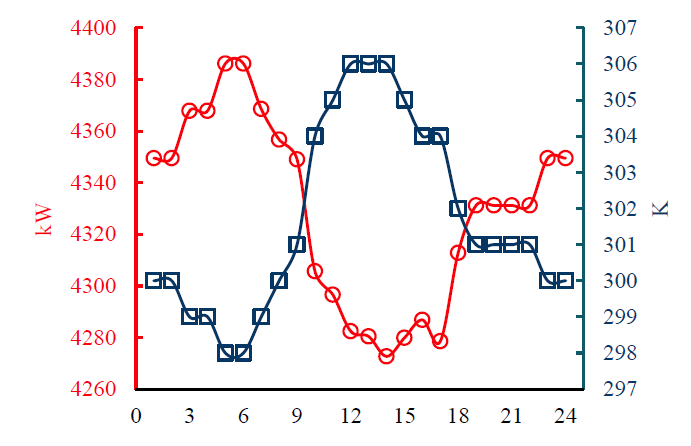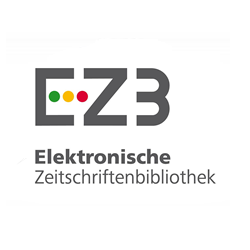Thermodynamic modeling of a Brayton cycle hybrid solar thermal plant in Colombia
DOI:
https://doi.org/10.17981/ingecuc.14.2.2018.12Keywords:
Solar Thermal Energy, Solar Concentration, Closed Brayton Cycle, Solar Radiation, Exergy destructionAbstract
Introduction: In Colombia, there is great interest in the application of renewable energy and the diversification of the energy matrix. Therefore, in this work, are presented the results of the simulation of a hybrid solar thermal plant of closed Brayton cycle in Colombia, that receives heat from a concentration system of central tower and heliostats. The solar resource is estimated by a time model validated initially, additionally with a combustion chamber that uses natural gas as fuel, which guarantees the stability of the heat supplied to the plant. The location of the plant is selected based on the global and diffuse average monthly radiation per day, and additionally, a simulation of the main operating parameters is carried out, optimizing the power and overall performance as a function of the pressure ratio. Finally, an exergy analysis of the plant is developed, especially of the components affected by the variation of the radiation during the day.
Objective: Evaluate a thermal solar plant of closed Brayton cycle concentration, through an energetic and exegetical analysis under the environmental conditions of Colombia.
Methodology: Integrate a model of solar resource, an energetic model and an exergy model applied to the environmental conditions of Colombia in model language in a Dymola compiler.
Results: The evolution of the main operating parameters of the plant throughout the day, the variation of the performance and the power depending on the pressure ratio are presented and analyzed.
Conclusions: It is technically feasible the operation of a solar thermal plant of concentration of Brayton cycle in some places of Colombia, given the available solar resource and the fuel saving that it generates despite the detriment of the energetic and exegetical performance.
Downloads
References
S. Kalogirou, Solar Engineering Processes and Systems, San Diego: Academic Press Elsevier, 2009.
REN21, Steering Committee, Renewable Energy Policy Network for the 21st Century, Renewable 2016 energy Status Report, Paris, 2016.
Y . Goswami, Principles of Solar Engineering, Boca Raton, USA: CRC Press, 2015.
B. Liu y R. Jordan, “The Interrelationship and Characteristic Distribution of Direct, Diffuse ant Total Solar Radiation”, Solar Energy, vol. 4, pp. 1-12, 1960. https://doi.org/10.1016/0038-092X(60)90062-1
M. Collares-Pereira y A. Rabl, “Hourly Diffuse Fraction Correlation at a Tropical Location”, Solar Energy, vol. 53, pp. 505-510, 1994. https://doi.org/10.1016/0038-092X(94)90130-T
C. Gueymard, “Prediction and Performance Assessment of Mean Hourly Global Radiation”, Solar Energy, vol. 68, pp. 285-303, 2000. https://doi.org/10.1016/S0038-092X(99)00070-5
W. Le Roux, T. Bello-Ochende y J. Meyer, “A review on the Thermodynamic Optimization and Modelling of the Solar Thermal Brayton Cycle”, Renewable and Sustainable Energy Reviews, vol. 28, pp. 677-690, 2013. https://doi.org/10.1016/j.rser.2013.08.053
CSP Today, Concentrated Solar Power Market Report 2014, Business Intelligence Ltd, London, 2015.
C. Ho y B. Iverson, “A Review of High-Temperature Central Receiver Design for Concentrating Solar Power”, Renewable and Sustainable Energy Reviews, vol. 29, pp. 835-846, 2014. https://doi.org/10.1016/j.rser.2013.08.099
A. Avila-Martin, J. Fernandez-Reche y F. Tellez, “Evaluation of the Potential of Central Receiver Solar Power Plants”, Applied Energy, vol. 112, pp. 274-288, 2013. https://doi.org/10.1016/j.apenergy.2013.05.049
F. Collado y J. Guallar, “A Review of Optimized Design Layouts for Solar Power Tower Plants With Campo Code”, Renewable and Sustainable Energy Reviews, vol. 20, pp. 142-145, 2015. https://doi.org/10.1016/j.rser.2012.11.076
Y . Zhang, B. Lin y J. Chen, “Optimum Performance Characteristics of an Irreversible Solar-Driven Brayton Heat Engine at the Maximum Overall Efficiency”, Renewable Energy, vol. 32, pp. 856-867, 2007. https://doi.org/10.1016/j.renene.2006.02.008
R. Kehlhofer, F. Hannemann y F. Stirnimann, Combined Cycle Gas and Steam Turbine Power Plants, Tusla. Oklahoma, USA: PennWall Corporation, 2009.
L. Wu, G. Lin y J. Chen, “Parametric Optimization of a Solar-driven Braysson Heat Engine with Variable Heat Capacity of the Working Fluid and Radiation Convective Losses,” Renewable Energy, vol. 35, pp. 95-100, 2010. https://doi.org/10.1016/j.renene.2009.07.015
S. Sánchez, Modelización, Análisis y Optimización “Termodinámica de Plantas de Potencia Multietapas Tipo Brayton. Aplicación a Centrales Termosolares”, Tesis Doctoral, Universidad de Salamanca, Salamanca, 2012.
S. Sanchez, A. Medina y A. Calvo Hernandez, “Thermodynamic Model and Optimization of a Multi-Step Irreversible Brayton Cycle”, Energy Conversion and Management, vol. 51, pp. 2134-2143, 2010. https://doi.org/10.1016/j.enconman.2010.03.006
D. Olivenza-Leon, A. Medina y A. Calvo Hernández, “Thermodynamic Modelling of a Hybrid Solar Gas Turbine”, Energy Conversion and Management, vol. 93, pp. 435-447, 2015. https://doi.org/10.1016/j.enconman.2015.01.027
M. J. Santos, R. Mechan, A. Medina y A. Calvo Hernandez, “Seasonal Thermodynamic Prediction of the Performance of Hybrid Solar Gas-Turbine”, Energy Conversion and Management, vol. 115, pp. 80-102, 2016. https://doi.org/10.1016/j.enconman.2016.02.019
W. LeRoux, T. Bello-Ochende y J. Meyer, “The Efficiency of an Open-Cavity Tubular Solar Receiver for a Small-Scale Solar Thermal Brayton Cycle”, Energy Conversion and Management, vol. 84, pp. 457-470, 2014. https://doi.org/10.1016/j.enconman.2014.04.048
C. Xu, Z. Wang y F. Sun, “Energy and Exergy Analysis of Solar Power Plants”, Applied Thermal Engineering, vol. 31, pp. 3904 - 3913, 2011. https://doi.org/10.1016/j.applthermaleng.2011.07.038
V. Zare y M. Hasanzadeh, “Energy and Exergy Analysis of Closed Brayton Cycle Combined for Solar Tower Plant”, Energy Conversion and Management, vol. 128, pp. 227 - 237, 2016. https://doi.org/10.1016/j.enconman.2016.09.080
R. Vasquez Padilla, R. Benito y W. Stein, “An Exergy Analysis of Recompression Supercritical CO2 Cycles with Reheating”, Energy Procedia, vol. 69, pp. 1181 - 1191, 2015. https://doi.org/10.1016/j.egypro.2015.03.201
W. Xiaohe, L. Quibin y B. Zhang, “Thermodynamic Analysis of the Cascade Supercritical CO2 Cycle Integrated with Solar and Biomass”, Energy Procedia, vol. 105, pp. 445 - 452, 2017. https://doi.org/10.1016/j.egypro.2017.03.339
National Aeronautics and Space Administration, “NASA,” [En línea]. Available: https://eosweb.larc.nasa.gov/sse/. [Último acceso: 26 11 2017].
J. Cenguel y M. Boles, Termodinámica, Ciudad de México: McGraw Hill, 2011.
K. Wark y D. Richards, Termodinámica, Madrid: Mc-Graw Hill, 2001.
J. Duffie y W. Beckman, Solar Engineering of Thermal Process, New Jersey: John Wiley and Sons, 2006.
N. Jubeh, “Exergy Analysis and Second Law Efficiency of Regenerative Brayton Cycle Isothermal Heat Addition”, Entropy, vol. 3, pp. 172 -187, 2005. https://doi.org/10.3390/e7030172
J. Parrott, “Theoretical Upper Limit to the Conversion Efficiency of Solar Energy”, Solar Energy, vol. 21, pp. 227 - 239, 1978. https://doi.org/10.1016/0038-092X(78)90025-7
Y. Wanxiang, L. Zhengrong y X. Tongbin, “New Descomposition Models to Estimate Hourly Global Solar Radiation from the Daily Value”, Solar Energy, vol. 120, pp. 87 - 99, 2015. https://doi.org/10.1016/j.solener.2015.05.038
R. Mejdoul y M. Taqi, “The Mean Hourly Global Radiation Prediction Models Investigation in Two Different Climate Regions in Morocco”, International Journal of Renewable Energy, vol. 2, nº 4, 2012.
W. Wan Nik, M. Ibrahim y K. Samo, “Monthly Mean Hourly Global Solar Radiation Estimation”, Solar Energy, vol. 86, pp. 379 - 387, 2012. https://doi.org/10.1016/j.solener.2011.10.008

Downloads
Published
How to Cite
Issue
Section
License
Published papers are the exclusive responsibility of their authors and do not necessary reflect the opinions of the editorial committee.
INGE CUC Journal respects the moral rights of its authors, whom must cede the editorial committee the patrimonial rights of the published material. In turn, the authors inform that the current work is unpublished and has not been previously published.
All articles are licensed under a Creative Commons Attribution-NonCommercial-NoDerivatives 4.0 International License.


 English
English
 Español (España)
Español (España)






















